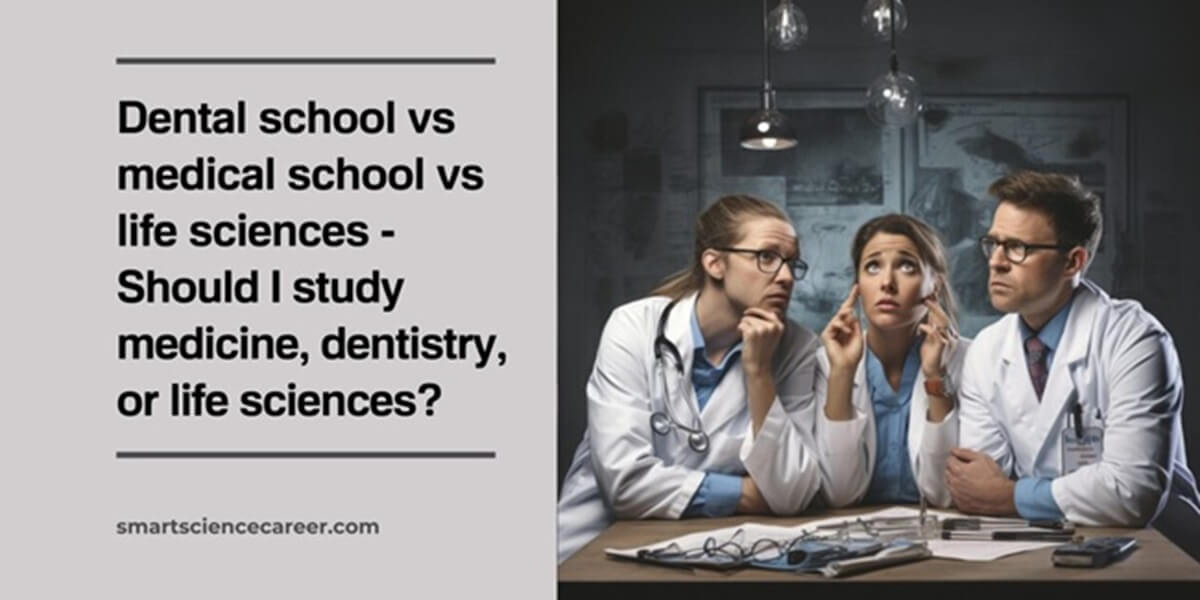Dental school vs medical school vs life sciences – Should I study Medicine, Dentistry, or Life Sciences?
Medicine, dentistry, or life sciences may have a similar appeal when deciding on your career path. Your choice will depend massively on your interests, talents, and long-term goals. See below for a comparison of the pros and cons of the three career paths to better decide what you truly want.
Medicine, Dentistry, or Life Sciences as Career Paths
Medicine as a Career Path
Medicine might be the right path for you if you are fascinated by the human body, its systems, and how to heal or alleviate ailments. As a medical student, you study intense courses and eventually specialize in a particular field, such as surgery, internal medicine, or pediatrics. The acceptance rates for medical schools hover around 36%, so it can be highly competitive.
Dentistry as a Career Path
On the other hand, dentistry may be a better fit if you are more drawn to healthcare’s oral and craniofacial aspects. Becoming a dentist generally takes less time than becoming a medical doctor, with dental school lasting four years, while medical school can take up to ten years to complete.
Life Sciences as a Career Path
But if you are more interested in the science behind living organisms and how they function, a degree in life sciences might align with your interests. Life sciences is a broad field that encompasses disciplines like biochemistry, biotechnology, cell biology, genetics, microbiology, and more. In this field, you will delve into topics such as the mechanisms of cellular life, genetic engineering, and ecological relationships.
How to Choose Between Medical School vs Dental School vs Life Sciences
When choosing between medicine, dentistry, and life sciences:
- Consider your personal interests and strengths!
- Research the different specializations within each discipline!
- Evaluate the time commitment, costs, and terms of competitiveness of each option!
- Assess work fulfillment, work-life balance, and job opportunities!
Thus, choosing between medicine, dentistry, and life sciences is very personal.
Can Doctors and Dentists Become Researchers?
Yes, you can pursue a research career as a doctor or a dentist. Both fields offer numerous opportunities for those interested in contributing to advancing medical and dental knowledge and discovering new treatments and technologies.
During your medical school or dental school education, you will likely participate in research projects to help you build research skills and explore your areas of interest.
After graduating from medical or dental school, you have various options to further your research career:
- Pursue an advanced degree: Many researchers in the medical and dental fields hold a Ph.D. in addition to their professional doctorate (MD or DDS/DMD). Completing a Ph.D. program will provide additional research training and open up more opportunities in academia and research institutions. It is also nearly always a prerequisite for becoming an assistant or associate professor.
- Apply for fellowships and grants: Various funding opportunities are available for doctors and dentists who want to conduct research. For example, the National Institutes of Health (NIH) and other organizations offer research grants and fellowships to support your work.
- Combine clinical practice with research: Many doctors and dentists work in academic medical or dental centers, where they can combine their clinical duties with research projects. This allows them to maintain their skills as practicing clinicians while contributing to their field’s body of knowledge.
Can Life Scientists Become Doctors or Dentists?
No, a degree in Life Sciences does not equate to a qualification as a doctor or dentist.
While a strong foundation in the Life Sciences can undoubtedly provide students with an excellent academic base for medical or dental school, it should be clarified that medical and dental degrees require specialized educational routes, including rigorous coursework, laboratory studies, and extensive clinical rotations (see below).
However, Life Sciences graduates who aspire to become a doctor or a dentist can find their background beneficial, especially if they are interested in pursuing research within these fields.
They must complete all specific courses, but the Medical School may accept some required courses from the Life Sciences studies as “equivalent.” Thus, you might be freed from participating in equivalent courses.
The transition can be a lengthy process, as it involves not just the time-intensive dental or medical school studies but also an intensive research period.
Briefly, I would not recommend combining these studies if you have no clear idea of the added value.
How Do the Curricula Differ Between Medical School, Dental School, and Life Sciences?
The curricula of dental and medical schools are rooted in biology, similar to life sciences. There’s a lot of similarity between the curricula of medical and dental schools during the initial years, often focusing on foundational subjects like anatomy and physiology.
However, in contrast to life sciences, their courses are more oriented toward clinical practices, patient care, and diagnostic and treatment methods.
Medical School Curriculum
In medical school, you’ll dive into a comprehensive curriculum, studying anatomy, physiology, biochemistry, and more. During the first two years, you will primarily focus on classroom-based learning, attending lectures, and participating in lab work.
The final two years typically consist of clinical rotations, where you’ll gain practical experience under supervision in various healthcare settings like hospitals and clinics. You will have the opportunity to explore very different medical specialties ranging, for example, from surgery, dermatology, and internal medicine to psychiatry during your rotations.
Dental School Curriculum
In dental school, you will undergo a comprehensive education focusing on oral health and dental techniques. The curriculum typically includes biomedical, behavioral, clinical, and dental material sciences. You’ll learn about preventing, diagnosing, and treating oral diseases and dental procedures like fillings, extractions, and root canals.
You will also gain hands-on experience through clinical rotations and externships as an essential part of dentistry education. This will help you develop the necessary skills to become a competent and confident dentist.
Life Sciences Curriculum
In Life Sciences, the curriculum predominantly focuses on understanding living organisms’ biological aspects. It encompasses many disciplines, including biology, biochemistry, microbiology, zoology, ecology, and genetics.
Throughout the study, students gain a deep comprehension of the fundamental processes that govern life, such as inorganic chemistry, cellular respiration, protein synthesis, DNA replication, and evolution. Moreover, the life sciences curriculum often includes the study of plant and animal life, biodiversity, conservation, and ecosystem dynamics.
Laboratory components supervised by a faculty member are integral to this curriculum, offering hands-on experiences to students that complement their theoretical learning.
Duration of Dental School vs Medical School vs Life Sciences
The duration of the three different types of studies depends on the curriculum, the institution, and personal goals and skills.
Duration of Medical Studies
The duration of medical programs differs substantially between countries – in the US and Canada: 4 years; in the UK: 5 years; and in continental Europe: 6 years.
However, it is more complicated. American and Canadian schools require an undergraduate degree in science (Biology, Chemistry, etc.) to be eligible. The duration of such programs is 3 or 4 years. Now, let’s calculate. To get an MD in the US, you must study for 7 or 8 years – a pre-med undergraduate degree (3 to 4 years) plus a medicine course (4 years).
In the UK, graduates must complete 1 year of the Foundation Programme (F1) before applying for full GMC registration.
In addition, after med school, you will need to complete a residency program, which can range from 3 to 7 years, depending on your chosen specialty.
Duration of Dental Studies
Similar to medical school, the duration of dental school in the US and Europe varies.
In the US, it typically takes four years to complete a dental degree program, either a Doctor of Dental Surgery (DDS) or a Doctor of Dental Medicine (DMD) degree. After completing the degree, aspiring dentists can choose to pursue general dentistry residency programs, which usually last for one year. Specialization in a dental specialty program requires additional years of residency training.
In Europe, dentists’ undergraduate dental education duration is five to six years, depending on the country. However, there may be exceptions, such as in Switzerland, where dental education may require four years of training for orthodontic specialists.
Upon graduation, you may choose to pursue additional training in specialized areas of dentistry, such as pediatric dentistry, orthodontics, or oral surgery, which can take another 2-6 years, depending on the specialty.
Duration of Life Sciences Studies
Generally, the framework for higher education degrees in the United States and Europe is similar, comprising a Bachelor’s degree, Master’s degree, and PhD. However, the duration of these programs can differ due to various factors, including the flexibility of the curriculum, prerequisites, and intensity of the programs.
In the US, the typical undergraduate (Bachelor’s) degree in the United States takes about four to six years. After completing an undergraduate degree, students can pursue a Master’s degree, which usually takes about two years, and then a PhD, which typically requires four to six years.
The typical undergraduate (Bachelor’s) degree in Europe takes three years, followed by a two-year Master’s degree and then three to four years for a PhD. In Europe, the duration of studies is usually structured according to the Bologna Process, a framework that makes academic degree standards more comparable and compatible throughout Europe.
Both medical school students and dental school students often benefit from guidance by a faculty advisor or faculty member who can provide insights into course selections, research opportunities, and career paths.
Is a Specialization or PhD Necessary?
Medicine: Specialization is not necessary to practice medicine, but it is required for some specialties, such as surgery and orthodontics. Specialization can also be helpful for physicians who want to focus on a particular area of medicine, such as pediatrics or cardiology.
Dentistry: Specialization is not necessary to practice dentistry, but it is required for some specialties, such as orthodontics and periodontics. Specialization can also be helpful for dentists who want to focus on a particular area of dentistry, such as cosmetic dentistry or pediatric dentistry.
Life sciences: Specialization is not necessary to practice in the life sciences, but it can be helpful for those who want to pursue a career in research or academia. Specialization can also be beneficial for those who want to work in a particular industry, such as pharmaceuticals or biotechnology.
A PhD is not required to practice medicine, dentistry, or life sciences but is necessary for most research positions. A PhD is also helpful for those who want to pursue an academic career. A Ph.D. takes typically 4-6 years. Read more here: How long does it take to complete a doctorate?
What Is Harder? Studying Medicine, Dentistry, or Life Sciences?
In my humble opinion, this is a misleading question that is impossible to answer in a general way.
According to the American Dental Education Association, the competitiveness of medical school vs. dental school has changed over the years. Some argue dental school harder, while others believe medical school or life sciences pose greater challenges. All three require a significant commitment of time, effort, and dedication.
The difficulty of studying medicine, dentistry, or life sciences depends on the individual student’s strengths, weaknesses, and interests. Some students may find medicine the most challenging field, while others may find dentistry or life sciences more difficult. It is essential to carefully consider your interests and abilities when choosing a field of study.
Medical students must learn a vast amount of information about human anatomy, physiology, disease, and treatment. They must also develop strong clinical skills, such as patient interviewing, physical examination, and diagnostic and therapeutic reasoning.
Dental students delve deeply into the very specific area of oral health. They must learn about the anatomy and physiology of the teeth and gums, as well as the diagnosis and treatment of dental diseases. They must also develop strong manual dexterity and spatial reasoning skills.
Life sciences students must learn vast information about the intricate systems of living organisms, spanning molecular biology, genetics, ecology, and evolution. They must also develop strong analytical skills, including experimental design, data interpretation, and scientific reasoning.
Competitiveness of Dental School vs Medical School vs Life Sciences
Medical school is generally the most competitive of the three fields, followed by dental school and then life sciences. This is due to several factors, including:
- The number of applicants: More students apply to medical school than dental school or life sciences programs.
- The number of seats available: There are fewer seats available in medical school than in dental school or life sciences programs.
- The admissions requirements: Medical schools typically have high academic standards for applicants, such as high test scores.
Dental school is also competitive but not as competitive as medical school. Dental schools have slightly lower academic standards than medical schools, and more seats are available.
Life sciences programs are generally the least competitive of the three fields. This is because a wide variety of life sciences programs are available, and many are less selective than medical or dental schools.
Admissions Processes of Dental School vs Medical School vs Life Sciences
Admissions committees in medical school, dental school, and life sciences
Admissions committees are responsible for reviewing and evaluating applications to their respective programs. They typically consider various factors, including academic performance, admission test scores, letters of recommendation, personal statements, and extracurricular activities.
Admissions Processes for Medical Schools
Pre-medical students should be aware of the varying entry requirements for medical schools. Prospective medical students often require a strong foundation in basic sciences, including organic chemistry and human physiology. Keep in mind that acceptance rates in many medical schools are competitive, with successful applicants often demonstrating a strong grade point average (GPA) and impressive test scores.
The admission processes differ substantially in different countries!
In the US, the medical school admission process is known to be highly competitive and rigorous. There is considerable debate about whether medical school rankings matter for medical school applicants.
The admission process in the US involves meeting specific academic requirements, such as a high GPA and competitive test scores (MCAT), and demonstrating clinical experience, research involvement, and strong letters of recommendation. The application process in the US is generally decentralized, with each medical school having its own admissions criteria and timeline.
The Medical College Admission Test (MCAT) is a significant requirement for those aiming to enter medical schools in the US and several other countries. The MCAT is a standardized test used for medical school admissions, for example, in the United States, Canada, Australia, and the Caribbean. The MCAT is not required for medical school admissions such as New Zealand, India, or most European countries.
Upon completion of medical or dental school, graduates must pass licensure exams. For dentists in the United States, this involves the National Board of Dental Examinations administered by the American Dental Association.
Medical school admission processes in the UK and continental Europe differ among countries and individual institutions. Each country has its own intricacies and regulations. Similarly, the acceptance rate varies.
For example, some countries have medical schools that primarily teach in the local language, while others offer programs taught in English to cater to international medical school students. European medical schools often have different admission requirements, including academic qualifications, entrance exams, and interviews. Some European countries have a centralized application system.
The MCAT is not required for medical school admissions in Europe. However, a variety of other tests may be needed, depending on the country and school to which you are applying.
Some of the most common medical school admission tests in Europe include:
- United Kingdom: UCAT (University Clinical Aptitude Test) or BMAT (BioMedical Admissions Test)
- Ireland: HPAT (Health Professions Admission Test)
- France: PACES (Parcours d’Accès Spécifique Santé)
- Germany: TMS (Test für Medizinische Studiengänge)
- Italy: IMAT (International Medical Admissions Test)
- Spain: MIR (Médico Interno Residente)
- Sweden: HPAT (Health Professions Admission Test)
It is important for prospective applicants to thoroughly research and understand the specific requirements and processes of the professional schools they are interested in.
Admissions Processes for Dental Schools
In both the United States and Europe, the admission process for dental schools involves several stages, but applying to dental school differs considerably due to different educational systems and cultural contexts.
The admission process for dental schools in both the United States and Europe revolves around a comprehensive evaluations of the dental school applicant, although the specific requirements and the methods used can vary significantly.
In the United States, the admission process for the 66 dental schools is highly standardized and competitive, with approximately 25% of applications rejected annually due to unfulfilled requirements. T
The American application process usually includes an assessment of the academic achievements of the dental applicants, such as completing prerequisite courses, a minimum number of years of undergraduate study, and average undergraduate GPA requirements.
Dental schools, whether they offer a Doctor of Dental Surgery degree (DDS) or a Doctor of Dental Medicine (DMD), require students to complete a four-year curriculum. First and second-year students generally focus on biomedical sciences with laboratory-based clinical training.
In contrast, third and fourth-year students get hands-on clinical experience to build their clinical skills in patient care. Additionally, a Dental Admission Test (DAT) score is typically required when an applicant applies to an accredited dental school.
In Europe, dental school admissions also employ a comprehensive evaluation of applicants, but the process can be more diverse, reflecting the unique contexts of individual countries. For instance, some European countries use the same admission procedures for both medical and dental students, which is different from the US, where there are separate admission processes for medicine and dentistry.
Admissions Processes for Life Sciences Studies
In the US, admission to life sciences programs typically involves a standard application process across universities, such as through the Common Application. Students must provide transcripts showing their high school GPA, letters of recommendation, standardized test scores (like the SAT or ACT), and often a personal statement or essay.
While not always the case, many programs may ask for coursework in relevant subjects (like biology, chemistry, and physics) or even Advanced Placement (AP) tests in these subjects. This process generally applies to various life sciences majors, such as pre-med, microbiology, ecology, and biotechnology.
The admission process in Europe can vary significantly between countries and universities. It generally involves an application through a centralized online system or the university’s application system, but the specific requirements and process can vary substantially.
Students are generally expected to provide evidence of previous studies relevant to the chosen program. They may need to meet specific requirements, such as proficiency in the language of instruction and possibly specific high school subjects.
As for specialized Ph.D. programs, admission generally involves applying directly to a specific program, often with a proposed research project and potential supervisor. This is similar in the US and Europe.
Costs of Dental School vs Medical School vs Life Sciences
Costs for Medical Schools
The cost of attending medical school varies depending on factors such as the school’s public or private status and your state residency. Keep in mind that this cost doesn’t include living expenses, textbooks, and other associated fees. Often, scholarships, grants, and student loans are available to help offset medical school expenses for those who qualify.
No surprise, the cost of attending medical school varies between the United States and Europe. In the United States, medical school education can be quite expensive. According to data from the Association of American Medical Colleges (AAMC), the median four-year cost of attendance for the Class of 2020 ranged from $255,000 to $337,000.
Pre-med students must consider substantial debt after their studies – at least in the US. This high cost of education results in a significant amount of debt for medical students, with 84% of students graduating with $100,000 or more in average debt. Tuition fees in the United States are often higher for private medical schools than public institutions.
The cost of attending medical school in Europe tends to be lower compared to the United States. Many European medical schools receive funds and subsidies from local governments and the European Union, allowing them to offer more affordable programs. In some cases, European tuition fees can be almost five times cheaper than those in the United States.
However, it’s important to note that the cost of medical education can vary among European countries and institutions, and the specific details may vary depending on the country and the medical school.
Costs for Dental Schools
Dental education is a significant financial investment, especially in the United States, where the costs can vary significantly based on whether one attends public or private schools.
In the US, the American Dental Association reported in 2020 that the average annual cost of the first year of dental school ranges from $53,000 to $70,000 for students attending private or out-of-state dental schools, while public schools may cost closer to $40,000 per year for more affordable options.
Furthermore, the average total cost for four years of dental school in 2019 was reported to be $251,233 for residents and $321,575 for non-residents, which includes tuition, mandatory fees, and other associated program costs but does not account for living expenses.
Interestingly, many European dental schools offer education at a more affordable cost than their North American counterparts. The average dental education prices vary substantially between countries. For instance, countries like Slovakia, Romania, Bulgaria, and the UK are recognized for offering quality dental education at an affordable cost, albeit the latter’s tuition fees are slightly higher than the rest.
Costs for Life Sciences Studies
Studying life sciences in Europe and the US differs substantially and comes with distinct costs that extend beyond tuition, including living expenses and potential extra fees.
In the US, studying costs largely depend on whether the institution is public or private and whether the student is in-state or out-of-state. For example, the average tuition fees for an in-state student at a public college were approximately $10,000 per year, whereas out-of-state students paid an average of about $26,000.
At private colleges, the average annual tuition was close to $35,000. This does not include living costs, books, and other miscellaneous expenses, which can add several thousand dollars annually.
On the other hand, in many European countries, universities offer free or very low-cost education to EU/EEA students, though international students usually have to pay more substantial fees. See this article comparing the costs of studying in different European countries: How Much Does it Cost to Study in Europe?
For instance, per Austria’s information, average tuition fees are free for domestic/EU students and about €726.72 (~US$850) per semester for international students at all levels. Average living costs in Austria are approximately €11,400 (~US$13,350) per year.
Salaries in Medicine, Dentistry, and Life Sciences
Your future salary may be an essential criterion for your career choice. However, there is a problem.
Salaries differ dramatically between countries, regions, and cities, as well as between specializations within each field and expertise level.
Below, I give a rough overview of salary ranges. In the US, the Bureau of Labor Statistics offers detailed insights into earnings across the medical, dental, and life sciences fields. The numbers differ when you use other sources of information, such as PayScale, Indeed.com, salaryexplorer.com, Glassdoor, or others.
Thus, unfortunately, the information is so heterogeneous that I would suggest not to base your choice too much on a future salary that is difficult to predict.
Doctors’ Salaries
The average annual salary of a medical doctor varies significantly between the United States and several countries in Europe, with the United States typically offering higher remuneration. However, this range can also vary widely based on factors such as the doctor’s specialization, years of experience, and the region within a particular country.
In the United States, the average physician’s earnings were reported as $316,000, according to a recent International Compensation Report. Another source, PayScale, provides a salary range for US medical doctors with an average low of around $101,000 and an average high of approximately $416,000, with potential variation based on specialization and location.
In Europe, the average annual salaries for physicians can vary widely between different countries. For instance, according to the same International Compensation Report:
Germany – $183,000
United Kingdom – $138,000
France – $98,000
Italy – $70,000
Spain – $57,000
However, it’s important to remember that these US American and European salaries are *average* figures. Thus, a few doctors earn tremendous amounts of money, while the gross majority earn dramatically less than this average value.
The actual earning is substantially influenced by various factors, including specialty, experience level, and the country’s region. Moreover, when comparing physician compensation, other aspects such as the cost of living, taxation, and healthcare benefits in each country should also be considered.
Dentists’ Salaries
In the US, the salary range for dentists is quite broad. Payscale.com suggests that the average salary for a dentist is $147,803 in 2023. According to Dentaly.org, the average salary for a dentist is anywhere from $154,000 to $205,000. Finally, Indeed.com suggests a dentist’s average salary is $220,474 annually.
In Europe, the salary ranges for dentists differ substantially across various countries, for example:
Germany: According to salaryexplorer.com, dentists in Germany have an annual range from €47,760 (~ $53,727) to €165,600 (~ $186,670) [5].
France: According to salaryexplorer.com, dentists in France have a yearly average salary range from €60,800 (~ $68,545) to €179,000 (~ $201,587).
Netherlands: According to salaryexplorer.com, the range extends annually from €70,320 (~ $79,272) to €206,400 (~ $232,356).
These figures are all gross salaries (before tax deductions) and can vary depending on factors like years of experience, skills, geographic location, and the economic conditions of the respective countries.
Life Scientists Salary
In the US, life scientists’ salaries are notably diverse, affected by role, location, and experience. According to Glassdoor data, the median pay for a generic Life Scientist role is around $103,396 annually, while the 2022 BioSpace report suggests an average salary of $142,885 in 2023. The 2021 USA Wage survey shows an average pay of $80,140, with the top 10% earning $155,990.
In Europe, life scientist salaries vary by country, similar to the salaries of Doctors and Dentists.
In Portugal, Life Scientists typically earn around €54,600 ($65,231) annually, according to salaryexplorer data.
In Germany, a Life Science Specialist earns an average salary of €73,392 ($87,639) per year, according to Glassdoor data.
In the Netherlands, a Life Scientist has an annual income of about €90,200 ($107,650), according to salaryexplorer.com.
Career Opportunities After Dental School vs Medical School vs Life Sciences
The evaluation of the career opportunities depends largely on your personal goals. I would recommend discussing your ideas with at least three persons who work in the chosen area to get a more realistic idea of which career might fit you.
Physicians’ Careers
Medical School graduates have a broad spectrum of career opportunities awaiting them. Becoming a physician is the most obvious career path, where specialties can range from general practice to highly specialized fields such as cardiology, neurology, or oncology.
Beyond this, they can venture into research, contributing to the advancement of medicine through scientific studies. They can become general practitioners or work in hospitals, universities, laboratories, insurance companies, or biotechnology companies.
Additionally, they could become health consultants or administrators, work in public health and policy-making, or enter academia to teach future generations of doctors.
Dentists’ Careers
Dental School graduates predominantly find their career as practicing dentists, specialized in various fields such as orthodontics, periodontics, or pediatric dentistry. Dental professionals also find roles in research, policy-making, public health, and academia. They can work in hospitals, dental clinics, or educational institutions.
A degree in dentistry opens doors to a variety of specialty areas. After graduating, you might consider additional post-graduate training to become a pediatric dentist or an oral and maxillofacial surgeon.
These specialties involve a further understanding of oral medicine, oral care, and oral health, allowing you to offer more specialized dental care to your patients.
Dental professionals, whether general dentists or specialists, enjoy many career opportunities. Many dental school students aspire to open their own private practice after acquiring the necessary clinical experience and knowledge.
However, career opportunities aren’t just limited to clinical practice. Many dentists also engage in research opportunities or take on teaching roles at dental programs in universities or academic health centers.
An emerging field in dentistry is geriatric dentistry, addressing the oral health needs of aging populations. Some dentists may further their qualifications and transition into oral and maxillofacial surgery, which requires dual medical and dentistry qualifications.
Life Scientists’ Careers
Life Science students have diverse career options due to the broad base of their degree. They can pursue roles in research, either in academia or within industries like pharmaceuticals, biotechnology, food, water, and agriculture.
Positions in these sectors range from process engineers to biotechnologists and QA specialists. Life Sciences graduates also work in public sector roles, such as hospitals, research institutes, government agencies, and forensic departments.
Apart from this, some graduates might enter the communication field as scientific journalists or writers, contributing to the public understanding of science.
Benefits and Challenges After Dental School vs Medical School vs Life Sciences
There are other essential aspects of a career you should consider when choosing medicine vs dentistry or life sciences, including work-life balance, job security, scope of practice as well as fulfillment and happiness.
Work-Life Balance in Medicine, Dentistry, or Life Sciences
Medical professionals often face long hours, irregular schedules, and weekend shifts, particularly during residency. The need for continuous learning and staying updated on the latest advancements in medical science also adds to their workload.
Therefore, good work-life balance can be challenging for those in high-demand specialties but also for general practitioners.
Dentists usually have more regular hours and predictable schedules than physicians, but their work can be physically demanding due to the nature of dental procedures.
Working with a dental service organization post-graduation can provide dentists with valuable experience and a steady income, without the pressures of managing their own practice.
Life scientists, on the other hand, typically work in research settings with more regular hours. However, project and grant proposal deadlines and the demanding nature of experimental grant proposal writing and publishing can influence their work-life balance.
Job Security in Medicine, Dentistry, or Life Sciences
Medical professionals generally earn higher salaries with significant potential for income growth. However, in recent years, they also face increasing levels of student debt from medical school – at least in the US. The demand for healthcare services also increases job security in this field.
Dentists also have high earning potential and job security due to the consistent demand for dental care.
Life scientists’ job security varies depending on their specific role and industry, with those in commercial sectors often earning more than those in academia. Read more here: Will I find a job as a scientist?
Scope of Practice in Medicine, Dentistry, or Life Sciences
Medical professionals have a broad scope of practice, ranging from general practice to highly specialized fields. They diagnose and treat a wide array of health conditions, requiring a broad and deep knowledge base.
Dentists, while also diagnosing and treating health conditions, focus specifically on oral health. Their scope of practice is narrower but requires a high level of specialized knowledge. Some may specialize in areas like maxillofacial radiology.
Whether you are considering medical or dental school, it’s important to note that both paths require significant clinical training. Medical and dental students gain invaluable clinical experience throughout their education, particularly in the latter years of their respective programs.
On the other hand, life scientists often specialize in specific research areas. Their work typically generates new knowledge in their field rather than directly impacting patients.
Fulfillment and Happiness in Medicine, Dentistry, or Life Sciences
All three careers offer high levels of fulfillment. Medical professionals and dentists often derive satisfaction from helping patients improve their health and well-being and save lives. However, these professions can also be stressful due to the high stakes of patient care and the emotional challenges of dealing with illness and death.
Life scientists can find fulfillment in contributing to scientific knowledge and potentially developing new treatments or solutions to health problems. However, they may face frustrations related to the slow pace of research progress or difficulties in obtaining research funding.
Read more about the classical dilemma between striving for fulfillment and contribution versus advancing your career
Frequently Asked Questions
Which field is easier to finish? Medicine, dentistry, or life sciences?
All three require a significant commitment of time, hard work, and dedication. However, depending on your personality, talents, and interests, you may find the specific skills needed for one of the professions easier to master:
If you want to be a doctor, you must learn a vast amount of medical information and develop strong clinical skills, such as patient interviewing, physical examination, diagnostic and therapeutic reasoning.
If you want to be a dentist, you must understand teeth and gum structures, diagnose oral issues, and refine your hand coordination and spatial reasoning skills.
If you want to be a scientist, you must learn a vast amount of information about molecular biology, genetics, ecology, and evolution. You must also develop strong analytical skills, including experimental design, data interpretation, and scientific reasoning.
Which field has the best job prospects?
All three fields have good job prospects. However, medicine is generally considered to have the best job prospects, as there is a high demand for physicians. Dentistry and life sciences also have good job prospects, but the demand may vary depending on the specific discipline.
Which field is right for me?
Choosing the the best field for you depends on your individual interests, abilities, and career goals. If you are passionate about helping people and have the academic credentials and personal qualities to succeed, then medicine or dentistry may be a good choice for you.
If you are passionate about understanding nature and doing experiments, life sciences are a better fit for you.
Acknowledgments
I have used AI systems, including Grammarly, Google Bard, and ChatGPT, to enhance the English and comprehensiveness of this article. This post may contain affiliate links, meaning I get a small commission if you decide to purchase through my link. Thus, you support smartsciencecareer at no cost to you!
Recommended Reading
The following articles may also interest you:
- Why salary matters in science careers
- PA vs MD salary – are the differences relevant?
- Free PhD programs versus fully funded PhD programs
- How long does it take to complete a doctorate?
- Does medical school ranking matter?
- Should I choose a big or a small university?
- Pharmacologist salary vs pharmacist salary – who earns more?
- Career or contribution
- I have no idea where I will be in two years
- Should I Become A Professor? Success Rate 3 %!
- Assistant professor and associate professor – what is the difference?
- Job interview outfits in science – what to wear?
- How to ask for a letter of recommendation?






